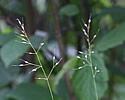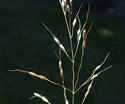Piptatherum canadense (Canadian Rice Grass)
| Also known as: | |
|---|---|
| Genus: | Piptatherum |
| Family: | Poaceae (Grass) |
| Life cycle: | perennial |
| Origin: | native |
| Status: |
|
| Habitat: | part shade, sun; dry sandy or gravelly soil; open woods, clearings, pine plantations, barrens, wooded slopes |
| Fruiting season: | July |
| Plant height: | 12 to 28 inches |
| Wetland Indicator Status: | none |
| MN county distribution (click map to enlarge): |  |
| National distribution (click map to enlarge): |  |
Pick an image for a larger view. See the glossary for icon descriptions.
Detailed Information
Flower: 

![[photo of panicle]](/udata/r9ndp23q/pd3/piptatheropsis-canadense-15-7-t.jpg) Loose, branching cluster at the top of the stem, 2 to 6 inches long, with 1 or 2 branches per node. Branches are up to 2½ inches long, mostly ascending to spreading, with 2 to 5 spikelets (flower clusters) per branch. Spikelets are loosely overlapping at the tip of a branch, narrowly lance-elliptic in outline, have a single floret, and a stalk about as long as or longer than the spikelet.
Loose, branching cluster at the top of the stem, 2 to 6 inches long, with 1 or 2 branches per node. Branches are up to 2½ inches long, mostly ascending to spreading, with 2 to 5 spikelets (flower clusters) per branch. Spikelets are loosely overlapping at the tip of a branch, narrowly lance-elliptic in outline, have a single floret, and a stalk about as long as or longer than the spikelet.
![[close-up of panicle branch]](/udata/r9ndp23q/pd3/piptatheropsis-canadense-15-1-2-t.jpg) At the base of a spikelet is a pair of bracts (glumes), both about equal in size and shape, thin and papery, hairless, awnless, weakly 1 to 3-veined, broadly oblong-elliptic often with an abruptly pointed tip (mucronate), 3 to 6 mm (to ¼ inch) long, 1.3 to 2 mm wide, and a little longer than the floret. Florets are surrounded by a pair of bracts (lemma and palea), the lemma leathery, brown at maturity, densely hairy with mostly appressed hairs, the body 2.2 to 4.5 mm long tapering to a straight to twisted awn 5 to 20 mm (to ~¾ inch) long; the palea is similar to the lemma but lacks the awn.
At the base of a spikelet is a pair of bracts (glumes), both about equal in size and shape, thin and papery, hairless, awnless, weakly 1 to 3-veined, broadly oblong-elliptic often with an abruptly pointed tip (mucronate), 3 to 6 mm (to ¼ inch) long, 1.3 to 2 mm wide, and a little longer than the floret. Florets are surrounded by a pair of bracts (lemma and palea), the lemma leathery, brown at maturity, densely hairy with mostly appressed hairs, the body 2.2 to 4.5 mm long tapering to a straight to twisted awn 5 to 20 mm (to ~¾ inch) long; the palea is similar to the lemma but lacks the awn.
Leaves and stems: 


![[photo of basal leaf clump]](/udata/r9ndp23q/pd3/piptatheropsis-canadense-15-6-t.jpg) Leaves are mostly basal, 2 to 8 inches long, 1 to 1.5 mm wide, flat or rolled up along the edges (involute), leathery, rough-textured, and stiff. Stem leaves are few, up to about 4 inches long, and mostly near the base.
Leaves are mostly basal, 2 to 8 inches long, 1 to 1.5 mm wide, flat or rolled up along the edges (involute), leathery, rough-textured, and stiff. Stem leaves are few, up to about 4 inches long, and mostly near the base.
![[photo of sheath, ligule and node]](/udata/r9ndp23q/pd3/piptatheropsis-canadense-15-1-3-t.jpg) The sheath is rough-textured with narrow papery edging. The ligule (membrane where the leaf joins the sheath) is 1 to 4 mm long, rounded or straight across at the tip and lacks a fringe of hairs. Nodes are smooth. Stems are unbranched, hairless, mostly erect, multiple from the base and forming loose to dense clumps.
The sheath is rough-textured with narrow papery edging. The ligule (membrane where the leaf joins the sheath) is 1 to 4 mm long, rounded or straight across at the tip and lacks a fringe of hairs. Nodes are smooth. Stems are unbranched, hairless, mostly erect, multiple from the base and forming loose to dense clumps.
Fruit: 
![[photo of mature spikelet]](/udata/r9ndp23q/pd3/piptatheropsis-canadense-15-1-6-t.jpg) The glumes become widely spreading as each grain matures, the florets dropping off individually leaving the glumes behind on the stalk. Grains (seeds) are about 2.5 mm long, narrowly lance-elliptic.
The glumes become widely spreading as each grain matures, the florets dropping off individually leaving the glumes behind on the stalk. Grains (seeds) are about 2.5 mm long, narrowly lance-elliptic.
Notes:
Canadian Rice Grass, also known as Piptatheropsis canadensis (formerly Oryzopsis canadensis), is a rare species in Minnesota, where it reaches the southern edge of its range. According to the DNR, it was first discovered in 2003 and only a handful of populations have been found since, most of which are concentrated within a 3-mile area in Lake County. It was listed as a Threatened species in 2013 due to the few locations, small populations and threats from habitat degradation and invasive species. It is distinguished from other grasses by the loose cluster of single-flowered spikelets usually 4 to 5mm long (excluding awns), thin, hairless glumes as long as the spikelet that become spreading at maturity, lemmas with straight or twisted awns and surface covered in mostly appressed hairs, leaves only 1 to 1.5mm wide that are flat or involute, and hairless ligules up to 4mm long. The overall form may be similar to Black-fruited Rice Grass (Patis racemosa, formerly Piptatherum racemosum or Oryzopsis racemosa), which has lemmas that turn black at maturity, hairy nodes, wider leaves (8+mm), and longer stem leaves with the basal sheaths bladeless or nearly so. The mature spikelets with spreading glumes and hairy lemma are similar to both Rough-leaved Rice Grass (Oryzopsis asperifolia), which has much broader leaves (3 to 8mm) and erect panicle branches, and Mountain Rice Grass (Piptatherum pungens or Piptatheropsis pungens, formerly Oryzopsis pungens), which has lemmas with very short awns (2mm or less) that usually drop off early.
Native Plant Nurseries, Restoration and Landscaping Services ↓
More photos
Photos courtesy Peter M. Dziuk taken in Lake County.
Comments
Have you seen this plant in Minnesota, or have any other comments about it?
on: 2017-11-27 13:43:48
This species and P. pungens are properly placed in Piptatheropsis, not Piptatherum. This change was made in the same paper that established that black-fruited rice grass belonged in Patis.
on: 2017-11-27 16:51:11
John, we generally follow whatever the Bell Herbarium publishes as their currently accepted taxonomy, though there are exceptions to that rule. As of this writing, Piptatherum stands on their list but we'll be reviewing taxonomy changes over the winter months and make whatever changes seem reasonable.







 Canadian Rice Grass plant
Canadian Rice Grass plant Canadian Rice Grass plant
Canadian Rice Grass plant panicle
panicle